Tag archives for: unemployed architects
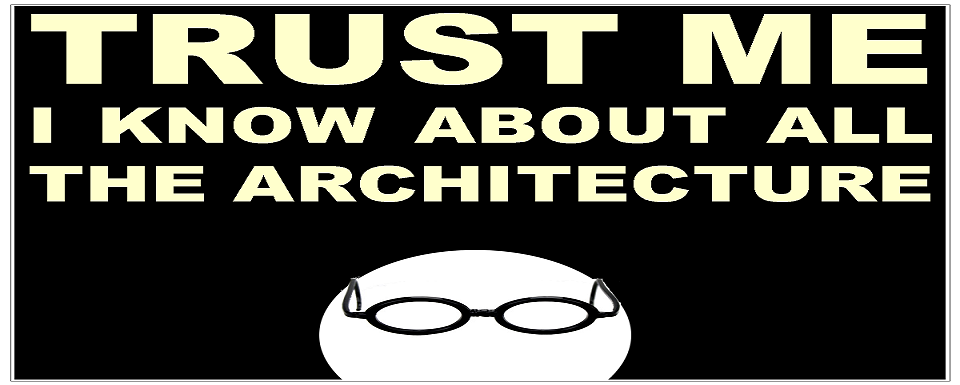
First… Why hire an Architect?
Why Does The AIA Say You Should Hire An Architect?
What do Architects do? And how can they help you?
Why hire an Architect? Few people realize how complicated it is to build-that is until they find themselves lost in a maze of design options, building codes, zoning laws, contractors and so on. No two building projects are exactly alike, so there is no single clear-cut path to follow. Whether you’re about to expand your current facility, adapt an existing structure to a new use, or construct an entirely new building, your building project represents a major investment that will affect the productivity and efficiency of your organization for years. Smart decision-makers know that the way to maximize such an investment begins with consulting an architect. Architects are the only professionals who have the education, training, experience and vision to maximize your construction dollar and ease the entire design and construction process.
Early involvement is key. By helping you define the building project, architects can provide meaningful guidance for design. They can conduct site studies, help secure planning and zoning approvals, and perform a variety of other pre-design tasks. Plus, when architects are involved at the earliest planning stage, they gain more opportunities to understand your business, develop creative solutions, and propose ways to reduce costs. The long-term result is a facility that adds to the productivity, efficiency, and effectiveness of your operation.
(Why hire an architect? Speak with an architect who is a member of The American Institute of Architects (AIA) at the earliest stage of your planning process).
Second. And the reason you are here in the first place…
What are the Top 5 Reasons to Fire Your #Architect?
Q. Are you an architect? Have you ever hired an Architect?
Why Hire an Architect
|
American Institute of Architects, architects, builders, CFA, Consulting For Architects, contractors, David McFadden, do not hire an architect, do you need to hire an architect, hiring an architect, jobs, jobs for architects, recession's affect on architecture, reddit, staffing, Staffing for Architects, unemployed architects
|

Recruiter Kristi Enigl
 Consulting For Architects, Inc. (CFA), a leading staffing firm for the architecture and interior design industry since 1984, announced today the hiring of Recruiter Kristi Enigl located in the New York office.
Consulting For Architects, Inc. (CFA), a leading staffing firm for the architecture and interior design industry since 1984, announced today the hiring of Recruiter Kristi Enigl located in the New York office.
Consulting for Architects (CFA) is pleased to welcome its newest member, Recruiter Ms. Kristi Enigl. CFA has been recruiting talented architects and interior designers since 1984 and placing them in long-term roles with top architectural and design companies throughout the United States. Their latest team member, Ms. Enigl, holds a Bachelor of Arts in Telecommunications from San Diego State University, and for the past two decades has served as senior recruiter and account manager, HR manager and career consultant for staffing firms and architectural companies alike.
For the original version on PRWeb visit here.
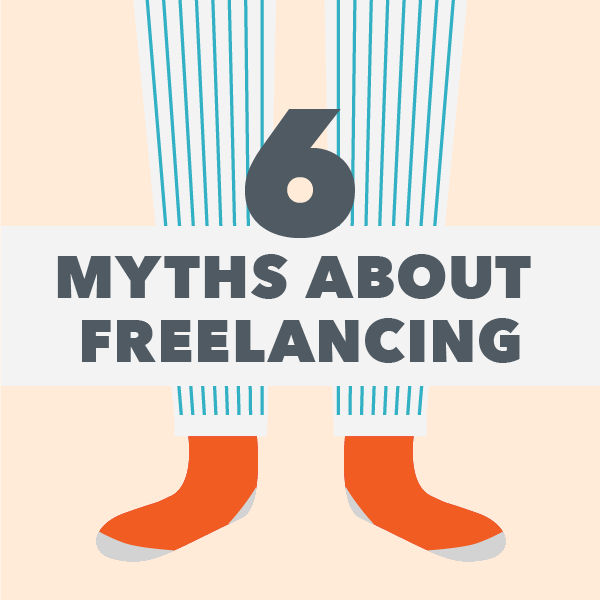
Author: Lindsay Van Thoen December 20, 2013; for the Freelancers Union
What happens when you tell someone you’re a freelancer?
In my experience, you’ll probably get some version of the following:
1. “I wish I could work in pajamas and sleep in every day!”
There may be some freelancers who don’t have to leave their house, spend their days watching Mad Men reruns, and only work 4 hours a day — but honestly, I haven’t met one yet.
Most freelancers are too busy going to client meetings, meeting with prospective clients, working out of the client’s office, going to networking events, working around their families’ schedules, and, you know, running their own business.
The idea that freelancers are sloppy and carefree somehow implies that freelancers just don’t work as hard as 9-5-ers. Not true!
2. “Ugh, the economy is so tough.” (I.e., freelancing is not a real job or people are only freelancers because they can’t find a real job.)
While it’s true that many traditional workers didn’t start freelancing by choice, it doesn’t mean that freelancers are poor, miserable souls who can’t wait to crawl back to corporateville.
Many freelancers either go independent by choice or find they like freelancing better, whether it’s because of more autonomy or better work/life balance or a host of other reasons that don’t involve desperation and agony.
It’s true that freelancing still doesn’t have the status of a C-level position in most fields. I expect that as more workers go freelance, a more realistic perception will develop: there are bad freelancers and good freelancers, happy freelancers and miserable freelancers, experienced and inexperienced.
We’ll soon see workers as whole people with a set of skills and services, not as the position they’re in.
3. “It must be so nice to never have anyone order you around!”
Wouldn’t it be great if this were true?
It’s true that freelancers are their own bosses — but sometimes, to maintain a good client-freelancer relationship, you have to let the client have what they want.
The best clients do say: “Here is the task I want, here are my expectations, I trust you to complete it well.” There are also clients who micromanage you the whole way. And a whole host of other people who think “freelancing” means “lowest rung on the totem pole that I can treat any way I want.” This is where freelancers have to educate clients about proper relationships and expectations.
4. “You must always have such exciting work!”
One of the best things about freelancing is that, to a certain extent, you get to choose the projects you’ll work on. If you work in a creative field, you’ll also be able to develop your own unique style/niche/speciality, so that people who come to you want YOU, and let you be your whole self.
But there are going to be boring days. There are going to boring projects or boring revisions or boring accounting.
Also, some freelancers are happier doing work they’re good at for steady clients than having constant new/exciting projects. They love the time they have with their family and they love the flexibility more than they love every single project they work on.
5. “Freelancers pad their invoices — you can always get them to negotiate down their fees.”
You probably won’t hear anybody say this to your face, but they will say it behind your back!
First, many freelancers are actually undercharging for their services. That’s because many people who go into freelancing assume that they should charge the hourly rate they got when they were an employee.
No. You need to charge that hourly rate, plus what you used to get for benefits that you now have to pay for yourself (~20-30%), plus an estimate of how much time it takes to land the client and ancillary things (like invoice filling), plus any equipment costs (like computers). This is an accurate representation of your value, not padding.
Freelancers who undercut the market rate hurt all freelancers and set expectations for cheap work.
6. “I could never freelance — I have too many financial obligations. It’s so insecure!”
The truth is that every job is insecure. Markets change, companies close or downsize.
The only security you have is the ability to provide a service of value that someone is willing to pay for. Your security is you. This isn’t a mindset, it’s a set of actions — all of which are easier said than done.
Smart freelancers make themselves recession-proof by having multiple income streams, constantly marketing themselves and forming new connections, and staying flexible by learning new skills, new programs, new fields.
When the economy leaves a smart freelancer in the lurch, he/she can pivot skills or rely on another income stream. Traditional employment can give one the illusion of stability, and that in itself is pretty risky!
What other myths about freelancing have you heard?

Lingering impact from the Great Recession slows gains in salaries
Over the last several years, most architecture firms have benefited from a general improvement in the economy as well as in the construction sector. Revenue at architecture firms increased almost 11 percent in 2012 from 2011 levels, according to U.S. Census Bureau figures, and firm payrolls have followed suit. But this modest improvement in business conditions has done little to lift compensation levels at firms. Between 2011 and 2013, average total compensation for architecture positions—including base salary, overtime, bonuses, and incentive compensation—increased only slightly over 1 percent per year, barely more than the average increase in compensation between 2008 and 2011, when the construction sector was still in steep decline.
Even this modest 1 percent increase in average architect compensation may overstate the experience of the typical architect during this period. Average compensation depends on the mix, by experience levels, of positions reporting. Since many less experienced architecture positions were eliminated during the downturn, current average compensation may reflect a higher share of more experienced (and more highly compensated) positions. Regardless, while average compensation for architecture positions increased a mere 0.7 percent per year compounded between 2008 and 2011, growth increased to only 1.1 percent per year between 2011 and 2013 (Exhibit 1.1).
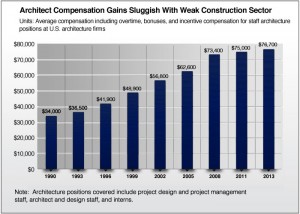
Architecture staff compensation tends to be more volatile over the business cycle than compensation for most other occupations. Over the past decade, compensation gains for architecture positions have more than kept pace with compensation across the entire economy. Architecture compensation increased 35 percent between early 2002 and early 2013, compared to just under 32 percent for all professional and related staff (typically defined as white-collar workers such as lawyers, accountants, etc.), and just over 29 percent for all private-sector workers (Exhibit 1.2).
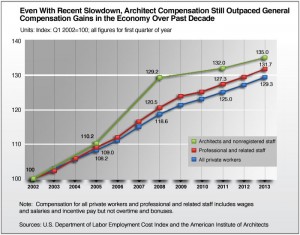
Compensation levels vary by firm size
Historically, large architecture firms have offered higher levels of compensation. These comparisons are more difficult for more senior positions because job responsibilities are difficult to compare across firms of different sizes. However, this disparity exists even for positions with relatively standard job descriptions such as Intern 1 or Architect 1.
At firms with fewer than 10 employees, Intern 1 compensation averaged 10 to 15 percent below national averages. At firms with more than 250 employees, Intern 1 compensation averaged more than 10 percent above the national average. A similar pattern held for Architect 1 positions: about 10 percent below the national average at firms with fewer than 10 employees, and almost 10 percent above the national average at firms with 250 or more employees.
Staff turnover and fringe benefits reflect improvement
Another sign that business conditions have stabilized across the profession is that benefits offered to employees have begun to modestly improve at many firms. While declining between 2008 and 2011 as firm revenues eroded, they rebounded modestly by 2013, with benefits packages averaging 18 percent of base salaries for professional staff. Benefits have bounced back faster at larger firms and remain significantly higher than those offered by smaller firms (Exhibit 1.3).
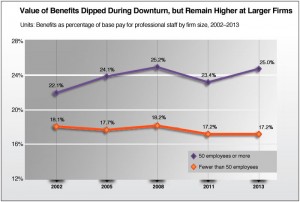
Recent Related:
AIA Compensation Survey: Architect Compensation Stagnant
Reference:
Purchase the 2013 AIA Compensation Report
New for 2013: Architect Compensation by Metro Area
Back to AIArchitect August 9, 2013
Go to the current issue of AIArchitect
Architecture Practice
|
aia, AIA NY, American Institute of Architects, architecture, Architecture billings index, Base Salaries, business, Compensation, economy, Great Recession, jobs, recession, Revenue, U.S. Census Bureau, unemployed architects
|

Could these words be costing you your dream job?
By Catherine Conlan, Monster Contributing Writer
Hiring managers and HR pros will often close out a job interview by asking an applicant if he or she has any questions themselves. This is a great opportunity to find out more about the job and the company’s expectations, but you can’t forget that the interviewer hasn’t stopped judging YOU. Here are 5 questions that can make a bad impression on your interviewer, scuttling your chances for getting the job.
1. “When will I be promoted?:
This is one of the most common questions that applicants come up with, and it should be avoided, says Rebecca Woods, Vice President of Human Resources at Doherty Employer Services in Minneapolis. “It’s inappropriate because it puts the cart before the horse.” Instead of asking when the promotion will occur, Woods says a better approach is to ask what you would need to do to get a promotion.
2. “What’s the salary for this position?”
Asking about salary and benefits in the first interview “always turns me off,” says Norma Beasant, founder of Talento Human Resources Consulting and an HR consultant at the University of Minnesota. “I’m always disappointed when they ask this, especially in the first interview.” Beasant says the first interview is more about selling yourself to the interviewer, and that questions about salary and benefits should really wait until a later interview.
3. “When can I expect a raise?”
Talking about compensation can be difficult, but asking about raises is not the way to go about it, Woods says. So many companies have frozen salaries and raises that it makes more sense to ask about the process to follow or what can be done to work up to higher compensation level. Talking about “expecting” a raise, Woods says, “shows a person is out of touch with reality.”
4. “What sort of flextime options do you have?”
This kind of question can make it sound like you’re interested in getting out of the office as much as possible. “When I hear this question, I’m wondering, are you interested in the job?” Beasant says. Many companies have many options for scheduling, but asking about it in the first interview is “not appropriate,” Beasant says.
5. Any question that shows you haven’t been listening.
Woods said she interviewed an applicant for a position that was 60 miles from the person’s home. Woods told the applicant that the company was flexible about many things, but it did not offer telecommuting. “At the end of the interview, she asked if she would be able to work from home,” Woods says. “Was she even listening? So some ‘bad questions’ can be more situational to the interview itself.”
With the economy the way it is, employers are much more choosy and picky, Beasant says. Knowing the questions to avoid in an interview can help you stand out — in a good way.

Unlike the stock market, which is setting at record highs, the housing market has yet to recover from the depths of the last recession. While real estate sales and prices are trending higher and are clearly better off than they were a few years (or even months) ago, a full recovery is still far off.
That’s not necessarily a bad thing, since it gives more people more time to take advantage of still low prices and interest rates. Nor is it a good thing, since it means as much as one-third of current homeowners are still underwater with their mortgages (eg. they owe more than the property is worth).
But with prices up, inquiries on the rise, and the spring selling season in full gear, it remains to be seen how this uptrend will play out.
For this installment of Investing 101, Shari Olefson, noted real estate attorney and author of the new book Financial Fresh Start, walks us through the basics of renting versus buying when it comes to making the investment of a lifetime.
1) Follow the “Rule of 15”
Before you make the decision to rent or buy, Olefson offers this rule of thumb: “If you can buy a home in your area for less than 15-times what your annual rent is, than financially it makes much more sense to buy than to rent.”
For example, if you pay $2,000 a month in rent (or $24,000 a year), she says the basic buy-rent cutoff price would be $360,000.
However, she warns that if rental rates in your area are abnormally high or the home you are looking at will need repairs, you must factor that in. Of course, she says “this is only one of several factors to consider,” but adds it is still “a great line in the sand” for narrowing down your initial search.
2) Determine What You Can Afford
Olefson says affordability is another key variable to consider. As a rough guideline, she suggests looking at properties that cost no more than 2.5 to 3 times your annual income on housing.
More…Even if you wanted to spend more, she says the mortgage market has changed drastically and financing requirements are much more strict.
“How you look on paper, what your credit looks like, and do you have the 20% down payment,” are also going to be factors of affordability to consider, as will your employment history.
3) Market Conditions
Whether you rent or buy, the laws of supply and demand certainly apply to housing prices. Right now, Olefson says for a number of reasons, there are simply fewer houses for sale than usual.
“We have four months worth of inventory right now, normally we have over six months,” she says, “that’s about a 25% decrease from this time last year, which is huge and what is driving those prices up.”
To be fair, she conceded part of the reason there are so few listings is because so many sellers are unsure about the market right now and whether or not they want to be in it. Still you have to be careful since national statistics smooth over some of the big statistical differences that vary from market to market, such as foreclosure and unemployment rates.
4) When to Become a Tenant Again
“The same formulas apply,” Olefson says, but that is really “a lifestyle feature” type of question; such as whether or not you may be moving or retiring in the near future. Even so, she says it’s a good idea to look at the local market and familiarize yourself with prices and rents and then run the numbers to see if ”it makes more sense to rent or to own your own home.”
Watch video at source Yahoo Finance
More interns are employed and getting licensed than during the throes of the recession. Read article http://www.aia.org/practicing/AIAB098254
aia, architect, architects, architecture, architecture jobs, Hiring trends, jobs, recession, unemployed architects
|
architecture, Architecture billings index, David McFadden, design, jobs, recession, unemployed architects
|
The City Council has unanimously approved plans to redevelop the historic Pier 57 at 15th Street and the Hudson River, turning the eyesore into an urban, cultural and retail hub.
The approval clears the way for construction to begin at the pier, which has served as a dock for ocean liners, a former MTA bus depot and a holding pen for rowdy protesters arrested at the 2004 Republican National Convention.

WITHOUT ‘PIER’: An artist’s rendering of Pier 57 after a City Council-approved restoration that will create 425,000 feet of retail space.
Calling it “a major victory for Manhattan’s West Side community,” Council Speaker and mayoral hopeful Christine Quinn said the pier will provide “a new, sorely needed source of revenue” for the Hudson River Trust, which oversees the pier.
“Soon they will transform Pier 57 from an unused waterfront space into an innovative hub, a culture of recreation and public market activity, all located within a restored historic structure,” said Quinn, whose district encompasses the pier.
The plan calls for creating roughly 425,000 square feet of retail and restaurant space built from re-purposed shipping containers, designed by Young Woo & Associates — the same firm that designed Dekalb Market in Brooklyn, also built from old shipping containers.
It will be an “incubator for cutting-edge local and international brands and merchants,” the company said.
It will also feature an amphitheater and a marketplace area made from old airplane fuselages and 160-square-foot “incuboxes” — small spaces for local merchants, artists and start-up companies.
There will also be educational components, such as cooking schools, art galleries, photography labs and music-recording studios. The Tribeca Film Festival will use the 100,000 square feet of outdoor space as a permanent venue.
A 141-slip marina and water-taxi landing space will surround the pier. Construction will begin in October, the company said.
The approval comes after years of wrangling by developers and community activists and after a more elaborate design — a $330 million proposal from real-estate developer Douglas Durst — was killed in favor of the less expensive plan offered by Woo’s company.
The now rusted pier was built in 1952 from three concrete slaps floated down the Hudson River.
“Today’s approval brings us one step closer to transforming Pier 57 into a recreational, cultural and retail center that will provide yet another great destination for the Hudson River Park community,” Hudson River Park Trust President and CEO Madelyn Wils.
Via NY Post [email protected]
architect, architects, architecture, architecture critic, architecture jobs, construction, Consulting For Architects, Engineering, Sculpture
|
architecture, Christine Quinn, City Council, David McFadden, Dekalb Market, design, Douglas Durst, Hudson River Trust, jobs, Madelyn Wils, MTA, Pier 58, recession, Republican National Convention, shipping containers, tribeca film festival, unemployed architects, Woo’s company, Young Woo & Associates
|
Online job ads for architects up 20% over year
 Online job advertisements for architects rose 20 percent during the last 90 days compared to the same time period in 2012, according to Wanted Analytics, a firm that tracks online job ads. There were a total of more than 16,000 architect jobs advertised in the past 90 days.
Online job advertisements for architects rose 20 percent during the last 90 days compared to the same time period in 2012, according to Wanted Analytics, a firm that tracks online job ads. There were a total of more than 16,000 architect jobs advertised in the past 90 days.
New York, Los Angeles, Washington D.C., San Francisco and Houston topped the list of metropolitan areas with the most job ads for architects.
“Autodesk AutoCAD” was the most commonly required skill in architect jobs. In the past 90 days, 5,500 jobs required CAD skills, representing about 35 percent of all hiring demand.
The most commonly required skills in architecture jobs include:
Autodesk REVIT Architecture
Oral and written communication skills
Detail oriented
Self-starting/self-motivated
Project management
Organizational skills
Bentley MicroStation
Microsoft Office
Adobe Photoshop
Watch a new CCTV America video from the AIA.org website that highlights 7 consecutive months of gains in the industry
Temporary hiring takes center stage
U.S. temporary employment jumped by 20,300 jobs in March, compared with the previous month, and the year-over-year growth rate ticked up, according to seasonally adjusted numbers released today by the U.S. Bureau of Labor Statistics. In addition, the number of temp jobs added in February was revised upward by 22,000 jobs.
Year-over-year growth in temp jobs had been decelerating since November. However, the number of temp jobs rose by 6.4 percent year over year in March, up from the 5.3 percent increase in February.
Further, the U.S. temp penetration rate rose to 1.94 percent in March from 1.93 percent in February.
However, the U.S. added fewer jobs overall in March than February. Total non-farm employment rose by 88,000 jobs in March compared with an increase of 218,000 in February – Sending a clear signal that firms are exercising caution, temporary hires outpaced permanent hires for the same period.
The U.S. unemployment rate still fell to 7.6 percent in March from 7.7 percent in February. The college-level unemployment rate, which can serve as a proxy for professional employment, was unchanged from February at 3.8 percent.
In other industries, construction added 18,000 jobs in March. The BLS reported construction has added 169,000 jobs since September.
Click on the chart below to enlarge.

Click on the chart below to enlarge.

This post is a composite of articles from Staffing Industry Analysts and AIA.org websites
aia, architect, architects, architecture, architecture jobs, construction, David McFadden, Hiring trends, recession, starting a business, Uncategorized, unemployed architects
|
architecture, Architecture billings index, AutoCAD, Autodesk, bentley microstation, BLS, business, construction industry, construction spending, design, Houston, jobs, Los Angeles, New York, recession, Revit Architecture, San Francisco, unemployed architects, Washington D.C.
|
When it comes to sourcing the right interview candidates, I’ve never been keen to use recruiters. But I recently changed my mind.

My company, Metal Mafia, has an excellent candidate screening process, a super training program, and a very successful team of employees to show for it.
But hiring has always been a difficult task for me because each time I get ready to hire, it takes me forever to find the right type of candidates to even get the screening process started.
Despite the fact that I carefully consider where to advertise for candidates–I try to maximize the search dollars and get a good mix of potential applicants–it always takes me a long time to find people suited well to the company, and therefore, even worth interviewing.
I’ve tried everything from placing ads on large job boards like Monster.com, to smaller specialized job boards that cater to sales hires or fashion jobs, to local university boards where I can post for free (or close to it). Each time, I experience the same slow crawl toward finally finding the right person. It has taken me up to five months to find the right kind of hire in the past. So in November when I decided I needed to think about hiring for the new year, I was not optimistic.
For me, recruiters have traditionally been out of the question because I figured they would be a waste of time and never be as good at sending me the right people for the job as I would be in reviewing resumes myself. They’re also too expensive for my small budget. But as I got ready to place my job ads again, one of my senior staff members came to me and offered me the name of a fashion recruiter she knew and thought could help. I was skeptical, but I called her anyway, figuring listening would cost me nothing.
The recruiter convinced me she would do a thorough job, but I still hesitated because of the price. I do not have large sums of money to devote to the hiring process, and by my calculations, when all was said and done, using the recruiter was going to cost me three times as much as my usual techniques. On the other hand, the recruiter would only charge me if she found someone I decided to hire, which meant I was risking nothing, and could always come back to my original methods. I bit the bullet and signed up, reminding myself “nothing ventured, nothing gained.”
The recruiter sent me the resumes of 10 entry-level candidates. I screened six by phone, met three in person, and found the right hire–all in a month. The cost suddenly became much less, because I saved so much time in the process, and because I got a pool of applicants who were decidedly better to choose from than in the past. Even more interesting, perhaps, was an insight the right candidate shared with me during the interview process. When I asked why she had chosen to work with a recruiter rather than post on job boards, she said “because recruiters make sure your resume gets seen, while submitting via the Internet is like sending your resume into oblivion.”
If most people these days are thinking like my new hire, the recruiters will clearly have the best selection of candidates every time. Looks like I’ve got an essential new hiring strategy.

Vanessa Merit Nornberg: In 2004, Vanessa opened Metal Mafia, a wholesale body and costume jewelry company that sells to more than 5,000 specialty shops and retail chains in 23 countries. Metal Mafia was an Inc. 500 company in 2009. @vanessanornberg
architect, architecture, architecture jobs, construction, Consulting For Architects, David McFadden, Design, Freelancer tips, Hiring trends, Interior design, jobs, recession, unemployed architects
|
aia, architecture, David McFadden, design, jobs, unemployed architects
|























